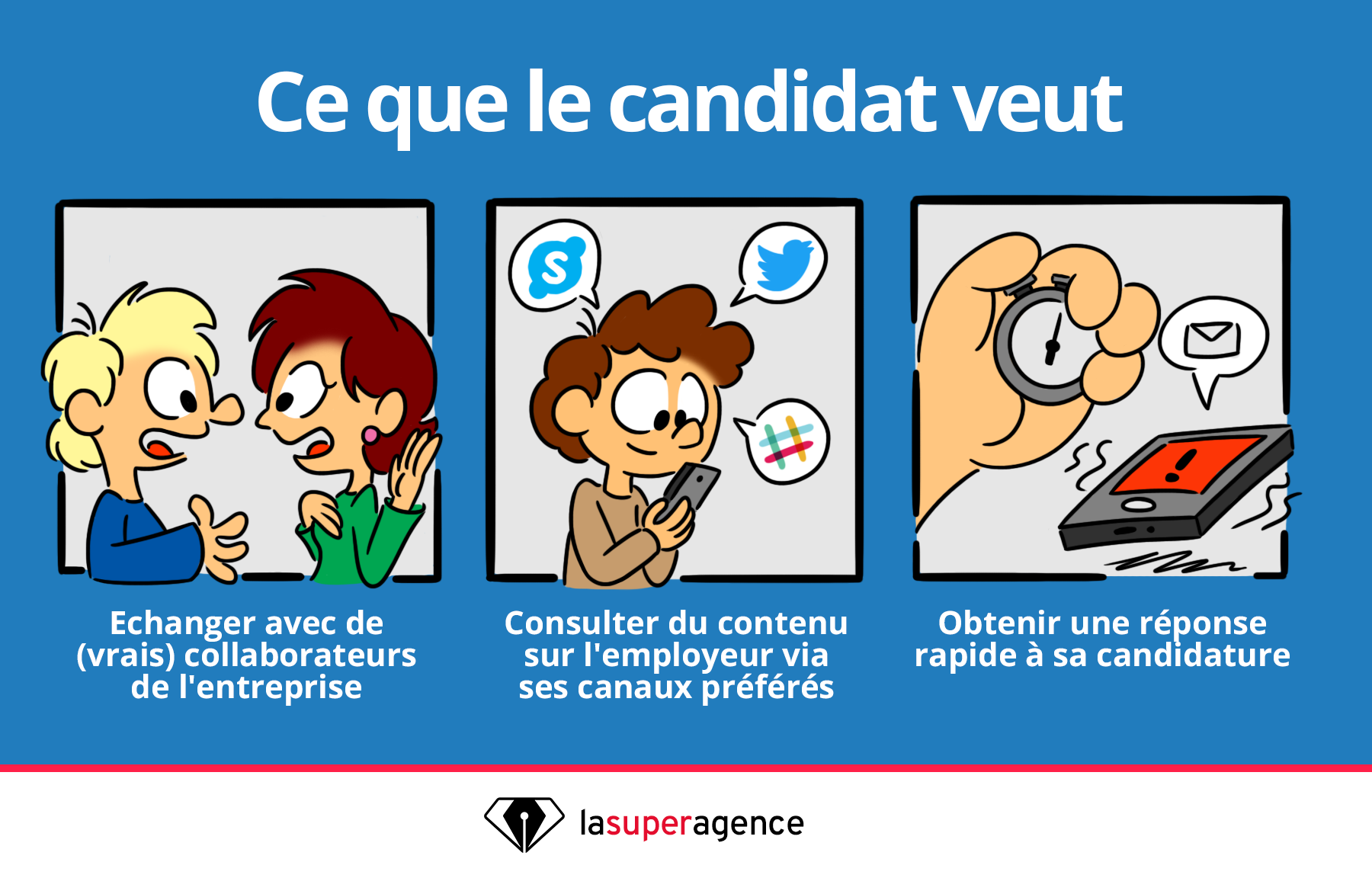The consideration of the candidate experience is a direct result of the new employer-employee relationship that has emerged over the past decade. The decision-making power in recruiting, which historically was in the hands of the employer, has gradually shifted to the candidate.
This "new deal" is due to a tighter-than-ever job market, incredible digital innovations, but also to a process that is increasingly moving toward the experience concept.
What is Candidate Experience?
7 Keys to Understanding Candidate Experience
5 Strategies to Improve Candidate Experience
What is Candidate Experience?
The candidate experience is defined as a candidate's perception of a company's recruitment process, from their very first, mostly digital, interaction (the famous ZMOT) to their actual recruitment or even onboarding.
Touchpoints during the recruitment process include the job search, the application, process, the timeframe for review of the application (time to-fulfill), or how to respond negatively to that application if applicable.
With Inbound Recruiting, the candidate experience begins even upstream of the job search: with quality content, the passive candidate will be able to identify the company as a good employer even before they have the actual plan to join it.
In other words, any strategy seeking to improve the candidate experience must consider each of the entry points through which the candidate passes leading them to interact with the employer.
Whether it's a phone contact with a recruiter or the user experience on the company's carrier page (more complex): each time, the candidate's feelings are analyzed.
The candidate experience actually begins long before the candidate applies to a site. According to an IBM study, 48% of current candidates have had previous interactions (or relationships) with the organization to which they are applying.
These interactions may be having family or acquaintances who work there, general knowledge of the company's reputation, being (or having been) a customer yourself.
This study also unsurprisingly reveals that only 2% of candidates had a poor opinion of the company before applying to it.
Thankfully, as the recruiting process goes digital, HR managers now have the opportunity to use ever more powerful online recruiting tools that enable a consistent and well-designed recruiting process.
To understand how technology can impact the candidate experience, let's take a closer look at the key elements that make it up.
Providing an experience that lives up to candidates' expectations has become a pre-requisite. It is a business imperative with very concrete consequences on the company's business development.

What is the candidate experience? The ability to meet their expectations.
For example, it was estimated that a poor candidate experience at Virgin Media cost the company $6 million in losses in a single year. Conversely, a good candidate experience can boost a company's growth.
Also according to IBM, candidates who have a good experience with your brand are more likely to become customers, when a bad experience can tarnish your image with negative word of mouth.
So, before we elaborate on ways to improve your candidate experience with an overall strategy, let's review the elements that make it up.

Now it's time to roll out the red carpet for your candidates!
7 keys to understanding the candidate experience
The candidate experience follows a candidate acquisition tunnel, thanks to increased process automation.
The employer brand has more touchpoints, which are all ways to influence the candidate experience.
Let's start at the beginning :
- The job search : the candidate's first interactions with your company happen through social networks, job boards, online advertising or your career site. Making sure your career site is easily found on search engines will save your candidates time and effort. This is the first step to a positive candidate experience.
- The application process: in addition to properly highlighting job openings, it's important that you provide clear and concise instructions for candidates to complete their application. For candidates who land on your career site after going through a job board, the job description and clear instructions are paramount for them to decide.
- Communication: One of the most frustrating things for a candidate is the lack of communication from the employer once they apply. According to a CareerBuilder study (on how employers can improve their candidate experience) almost 1/3 of those surveyed said they would like more communication during the recruitment process. Candidates would appreciate a simple text or email, even if their application was screened out during the initial screening.
- Feedback: If a candidate has been shortlisted by a recruiter, regular updates on the status of their application is much appreciated (in addition to keeping them involved in the process). This can be done through a simple automated message informing them of expected next steps, or a call from the recruiter. Regardless of the format, communication is essential throughout the process.
- The Interview: The interview stage is the best way to really get to know your candidates and assess whether they are a good fit for your company. It's also an opportunity for candidates to get to know your company a little better. A positive job interview is very important to convince candidates to join your organization. By using a structured interview process, you can make decisions in an orderly fashion. You will also avoid confusion. Repeated (and redundant) interviews with multiple team members can confuse candidates and add additional delays to the decision-making process. Speed is of the essence here for candidates who are eager to know how their performance will be judged. Inform candidates of the interview process in advance: video format, or face-to-face? Test(s) ? Questions and answers ? For the candidates, the interview stage is the opportunity to show their skills and to put forward their know-how. They want to arrive as prepared as possible.
- Onboarding: Onboarding is the ultimate step in the candidate experience. It is the opportunity to make the first day on the job memorable for the candidate. Onboarding is an opportunity to demonstrate to candidates that all the promises made during the recruitment process are in line with the reality of the company. If the first day consists of filling out a mountain of paperwork, interacting very little with new colleagues and receiving vague instructions, the Onboarding process can be difficult for the new employee. By following an effective Onboarding strategy, you can build confidence in your new hire and set them up for long-term success.
- Analytics: in order to optimize your recruiting efforts and improve the candidate experience, objectively analyze the steps by modifying touchpoints where necessary. For example, you can review your ATS (Application Tracking System) KPIs and compile data on candidate behaviors can be a great help in re-calibrating your candidate acquisition channel.
And don't forget:

5 strategies to improve the candidate experience
Now that we have established the key components of the candidate experience, the next question is how can we improve the candidate experience ?
Here are the strategies at your disposal:
- Applicant Tracking Systems: ATS (Applicant tracking system) is a crucial tool for streamlining and expediting your recruiting process. Most ATS solutions offer integrations with career sites (although the options are relatively limited). They make it easy to apply to social networks, job boards and company website pages. ATS tools also allow candidates to apply via their smartphones, without difficulty, thanks to adapted interfaces.
- Candidate Relationship Management System: CRMs (or Candidate relationship management system) automate the interaction between the company and candidates once they have applied. Full-featured CRM solutions integrate seamlessly with ATS and help you build an active and passive talent pipeline to keep candidates engaged with your employer brand. In addition, CRMs support automated personalization of communications to guide candidates through the recruitment process.
- Interview tools: face-to-face interviews are obviously still relevant. But offering video conference interviews demonstrates to candidates that you are being flexible. Managing interviews via video shows an inside view of your company culture and reduces the amount of time spent on the phone. Video interviews make the recruiting process more objective and data-driven, knowing that the same set of questions are asked of the candidate. With artificial intelligence (AI) and machine learning (ML) becoming more prevalent on video interviewing platforms, you can additionally now assess whether a candidate is a good fit for your company culture.
- Onboarding strategies: the candidate experience is not just about conducting the best possible job interview. Through the process of selecting the profile, and then onboarding it, the chosen individual is always in the candidate experience. The candidate has been pre-screened but still not hired. It remains to check references, while ensuring continuous feedback, to propose an offer of employment consistent with the profile or to facilitate the administrative procedures. Each of these steps contributes to shaping the candidate's perception of the company, right up to the final formalization of the hiring. A smooth Onboarding, meaning that it doesn't bury the candidate in paperwork and allows them to get a glimpse of their future workplace and the teams that will surround them makes a big difference.
- The Induction Mechanisms: Once the candidate is onboarded, they finally become an employee. But the transition from " candidate " to " productive employee " does not happen overnight. It takes several months for an employee to feel at ease in his or her new work environment and to fully understand the scope of his or her tasks. This is when the induction and orientation processes take place. These processes can confirm the new employee in his decision to join the company, as well as make him regret his choice. This window of time should be the moment when the company makes a special effort to make the newcomer feel expected. It should provoke enough motivation and desire in them that they feel their candidate experience was just a taste of their employee experience.
Providing a great candidate experience doesn't have to be complicated, or even expensive. Simply assess your current recruiting practices, identify when candidates are abandoning the process with you so you can improve the steps to close the gaps and provide a memorable experience.
And how would you redefine your candidate experience strategy?









